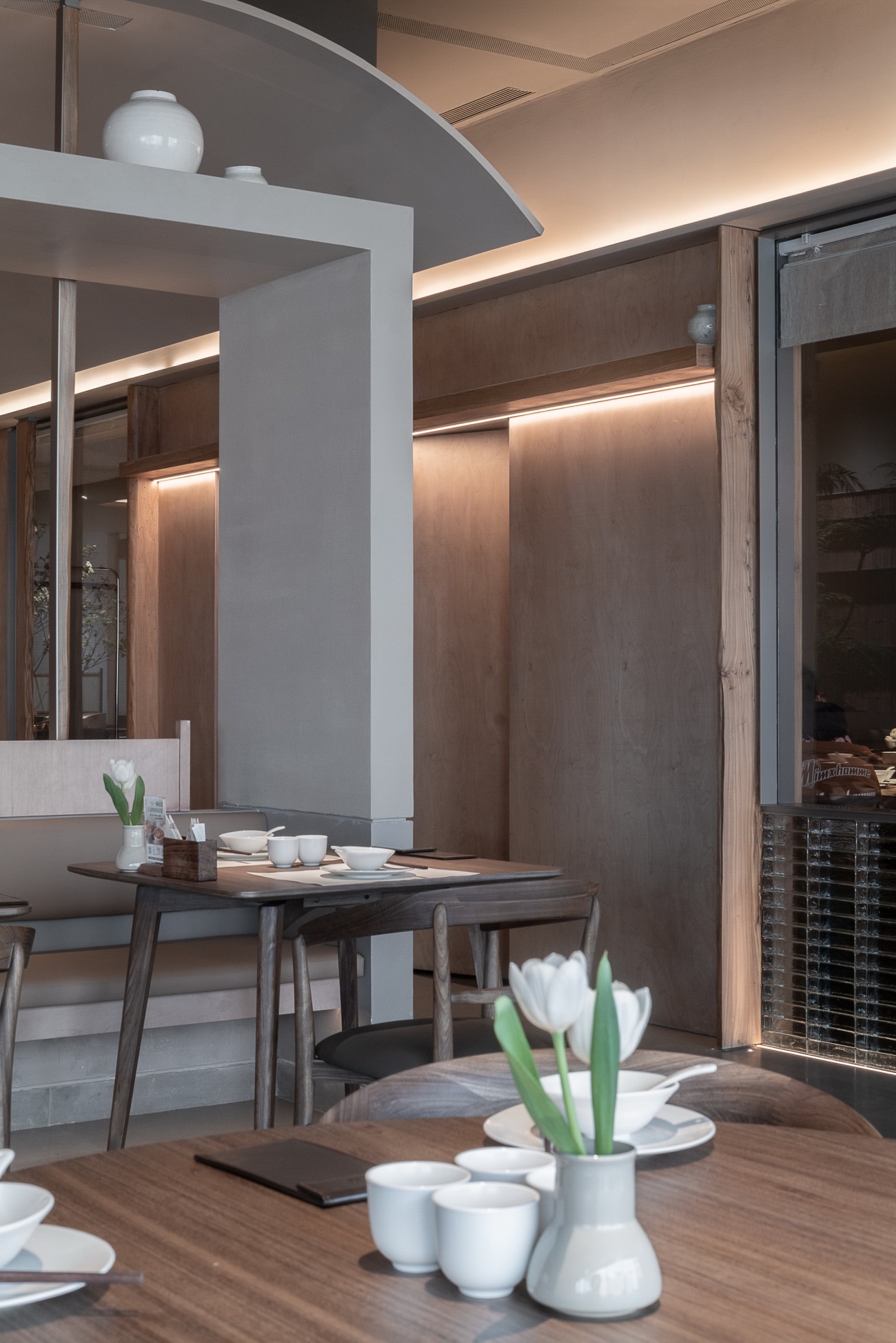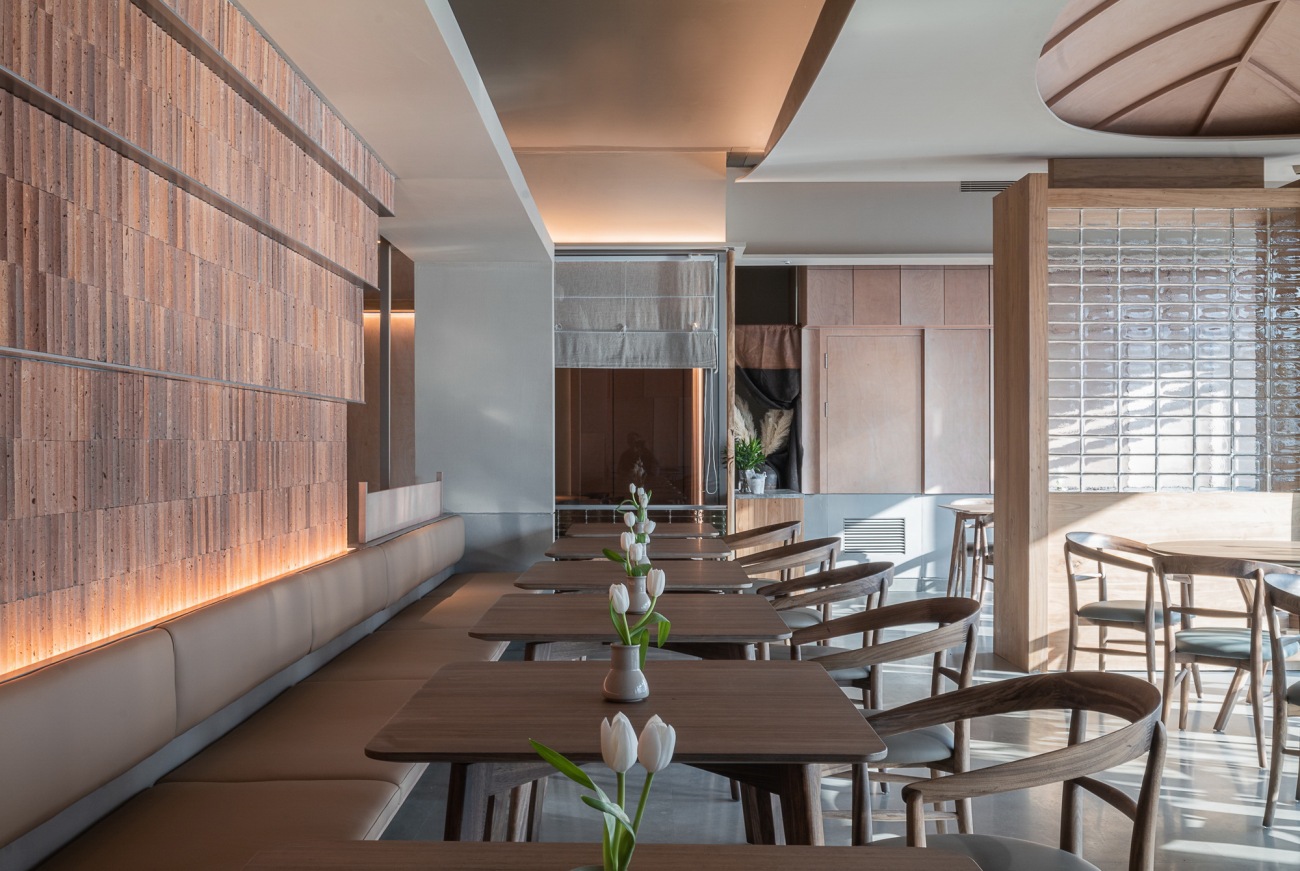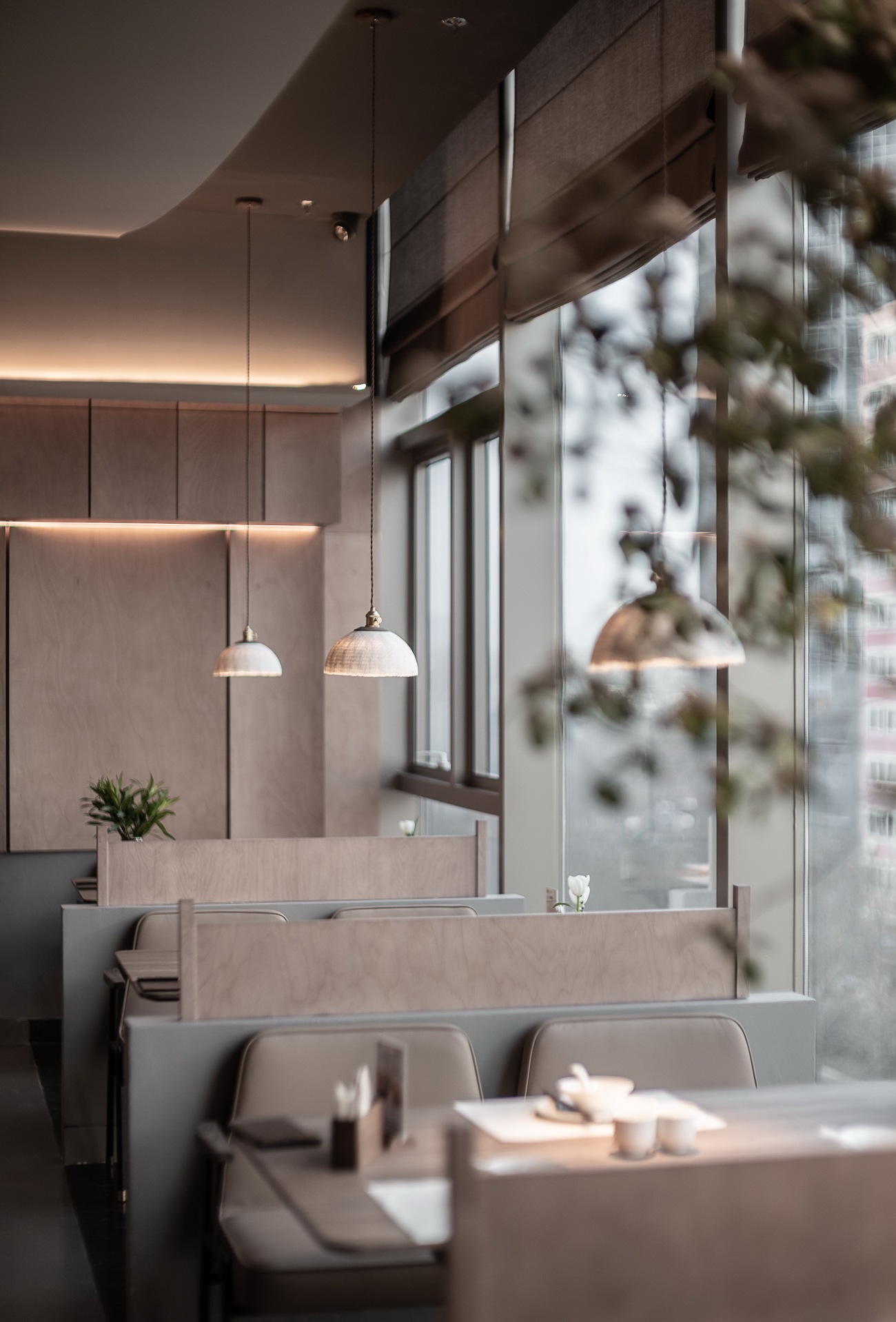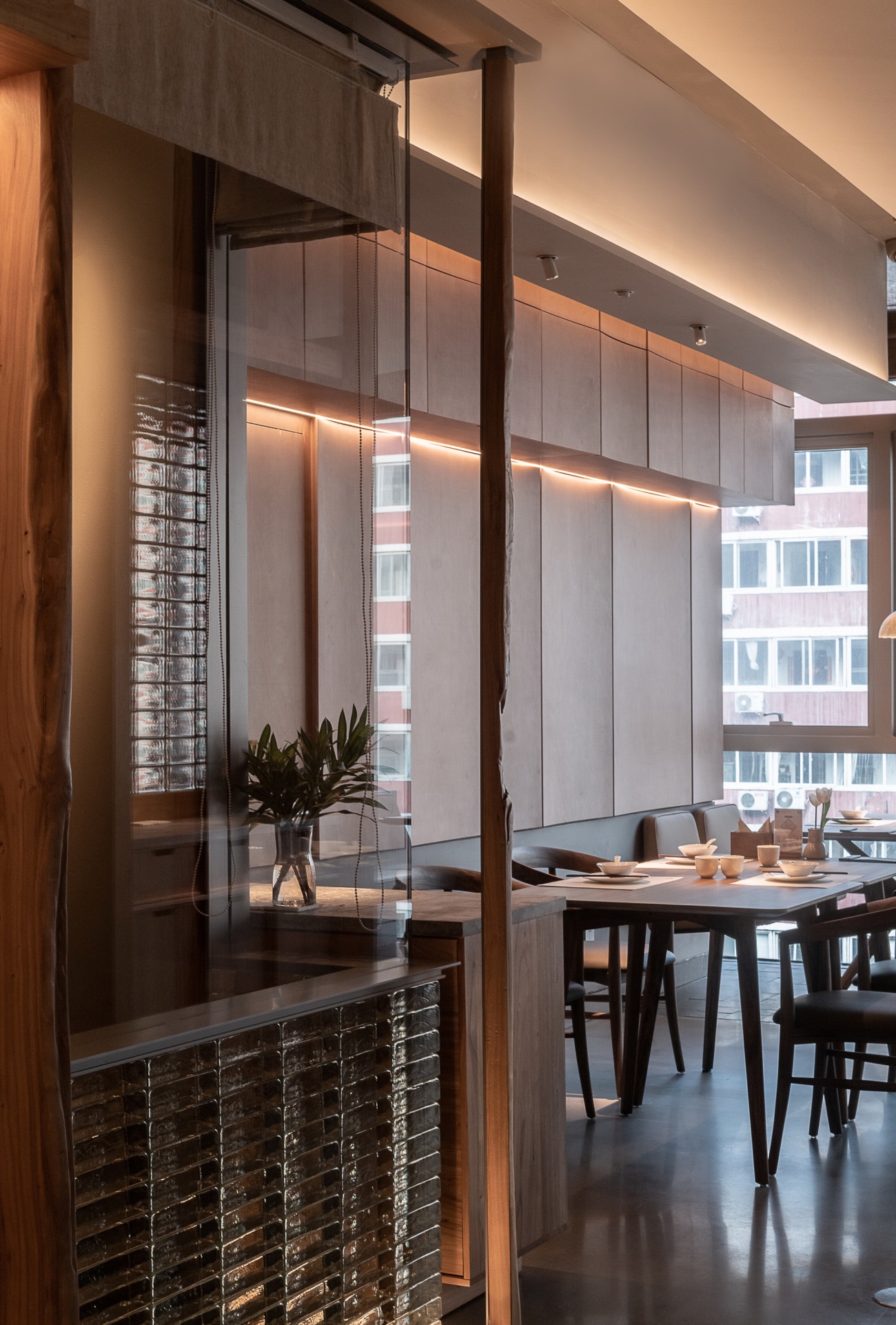媒体有个不完全统计,中国餐饮店的平均寿命大约是508天,这是一个令人沮丧的数据,尽管开店数量还在不断增长,但是关铺的速度更是让人触目惊心。尤其是最近两年餐饮行业生态呈现出快速迭代的特点,主打就是行业内卷。就在这种激烈竞争的背景下雁舍餐厅的第七家店(三里屯店)开业了。这也充分证明了雁舍品牌在的经济逆势的环境中也有着足够的竞争能力。
According to incomplete statistics from the media, the average lifespan of Chinese restaurant is about 508 days, which is a disappointed figure. Although the number of restaurants is still increasing, the speed of closing is shocking and heart wrenching. Especially in the past two years, the ecosystem of catering industry has shown a rapid iteration, with the main focus being internal competition. Against the background of fierce competition, the seventh store of the goose hut bistro (Sanlitun store) opened. This is also fully proves that the Goose Bistro brand has sufficient competitiveness in the economic downturn environment.
与雁舍相识十年有余,作为设计师连续十年为同一个品牌服务是非常罕见的。记得初识雁舍是2014年,那个时候我们对餐厅设计并不熟知,仅凭一颗热爱设计的初心,即便是最基础的动线问题对我们也是困难的。当然这里最要感谢创始人黄岳红女士对我们的信任与支持,黄女士是老餐饮人,对于餐厅有着执着的热爱和追求。尤其是对餐饮的理解远远超越了吃本身,她认为“餐”更多的是人与人情感上的表达,而不仅仅是对味蕾的刺激,经过多次的碰撞大家确认了雁舍的由来,即“大雁归巢,游子回家。”这是一个温暖的画面和家的感受,所以森林树枝作为雁的栖息之地,小房子寓意游子之家。虽说手法过于具象,但形式突出便于传播。或许当时我们真的没有能力处理更复杂的餐饮设计,只能用稚嫩的手法来表达朴素的情感。
Having known The Goose Hut Bistro for over ten years, it is very rare for a designer to serve the same brand for ten consecutive years. I remember first meeting in 2014, when we were not familiar with restaurant design. With a passion for design, even the most basic flow problems were difficult for us. Of course, we would like to express our gratitude to Ms. Huang Yuehong, the founder, for her trust and support. Ms. Huang is an experienced diner who has a persistent love and pursuit for restaurants. Especially in terms of food, her understanding goes far beyond eating itself. She believes that food is more about expressing emotions between people, rather than just stimulating taste buds. After multiple collisions, everyone has confirmed the origin of the Goose Hut Bistro, which is the wild goose returns home, the wanderer returns home. This is a warm scene and a feeling of home, so the forest branches serve as the habitat for geese, and the small hut symbolizes the wanderer’s home. Although the design skills look concrete, the form is prominent and easy to spread. Perhaps at that time, we really did not have the ability to handle more complex catering designs, and could only express simple emotions with immature techniques.
 |  |
回到三里屯的雁舍设计,形式上还是沿用了首店的元素。不是没有更新的思考,却是对过去十年的敬礼,为品牌,更为我们不变的初心。树林与房屋的依然存在,但设计师却保持着足够的克制,在这里设计尽可能摒弃具象符号化的形式。首店的树林抽象成了若干的竖向枝干,弧形的天花寓意着房屋的构造,“大雁归巢,游子回家”在这里有了更为隐喻的表达。
Returning to the design of the Goose Hut Bistro in Sanlitun, the form still follows the element of the first store. It is not without updated thinking, but a tribute to the past decade, for the brand, and even more for our unchanging original intention. The presence of forest and houses still exists, but designers maintain sufficient restraint and strive to abandon concrete and symbolic forms as much as possible. The forest in the first store has been abstracted into several vertical branches, and the curved ceiling symbolizes the construction of the house. ‘Wild geese return home, wanderers return home’ has a more metaphorical expression here.
 |  |
 |  |
但所有的这些都是对雁舍精神上的延续“和爱的人好好吃一顿饭”。很多时候设计除了解决功能问题,更多的是情感表达,这是从第一间雁舍就开始了的,是设计师对空间塑造上的情感,也是品牌的浓缩后与食客交流的情感,这种情感或许不能与设计初衷相互吻合,但这并不重要,只要您在就餐的过程中能与食物,人,或者空间有所共鸣,那怕只有一点点对于我们来说就足够了。
But all of this is a continuation of Goose Hut Bistro’s spirit, to have a good meal with the person she loves. Many times, design not only solves functional problems, but also focuses more on emotional expression. This starts from the first Goose Hut Bistro, which is the designer’s emotional shaping of the space, as well as the emotional communication with customers after the brand is condensed. The emotion may not be compatible with the original design intention, but it is not important. As long as you can resonate with the food, people, or space during the dining, even a little bit is enough for us.
 |  |  |
▽设计图
项目名称:雁舍(北京三里屯)
设计单位:无之设计
客户:北京雁巢餐饮有限责任公司
项目完成年份:2024年3月
建筑面积:323㎡平方米
项目地址:北京市朝阳区南三里屯路1号楼T+MALL商场4层(原通盈中心)
主创建筑师:赵爽,郑雅楠,佟炜佳
展陈设计师:杨雨萱
摄影版权:赵爽
施工单位:北京得艺建筑装饰工程有限公司
施工技术人员:肖圣平
合作供应商(排名不分先后):
石客照明(工程灯具);
上海新楹柯实业有限公司(墙面石材/地面石材) ;
尼威利特北京科技有限公司(墙面微水泥)
艺境空间(固定家具,活动家具);
永利圣源(窗帘布艺)
唐柏老石器(老石头)
北京竹青木业(桦木板)
材料:桦木板,榆木实木,弧形手工砖,微水泥地面,米色艺术涂料,老石头,玻璃砖,棉麻布料
Project name: the Goose Hut Bistro (Beijing Sanlitun)
Design: Wuzhi Design
Client: Beijing Yanchao Catering Co., Ltd
Project completion year: March 2024
Building area: 323 square meters
Project Address: 4th Floor, T+MALL Mall, Building 1, Nansanlitun Road, Chaoyang District, Beijing
(formerly known as Tongying Center)
Main architects: Shuang Zhao, Yanan Zheng, Weijia Tong
Exhibition designer: Yuxuan Yang
Photo credit: Shuang Zhao
Construction: Beijing Deyi Architectural Decoration Engineering Co., Ltd
Technical Engineer: Shengping Xiao
Collaborating suppliers (ranked in no particular order):
SIKI Lighting (engineering light);
Shanghai Xinyingke Industrial Co., Ltd. (wall stone/floor stone);
Niewielith Beijing Technology Co., Ltd. (wall micro cement)
Yijing space (furniture);
Yongli Shengyuan (curtain)
Tang Bai Old Stone Tool (old stone)
Beijing Zhuqing Wood Industry (birch board)
Materials: Birch wood board, elm solid wood, curved handmade bricks, micro cement floor, art painting, old stone, glass brick, cotton and linen fabric
更新日期:2024-05-13 16:41:11
非常感谢 无之设计 带来的精彩项目, 查阅更多Appreciations towards WUZHI Design for sharing wonderful work on hhlloo. Click to see more works!










































